History
The Kunzangdrak Goemba, or monastery, was built in 1488 by Pema Lingpa, Bhutan’s greatest Treasure revealer. Situated on the edge of a cliff that some say looks like a bodhisattva in the Tang Valley of the Bumthang District, locals believe that it could only have been constructed by a superhuman being. Since it was built into a cliffside, the hike up to the monastery, though physically demanding, rewards trekkers with gorgeous views of the Tang Valley from the temple at the top. Holy water drips down from the cliff, and legend says that its source was created by Pema Lingpa and Guru Rinpoche and allowed to fall by the dakinis. The complex consists of three buildings: Wangkhang Lhakhang, Khandroma Lhakhang, and Oezerphug, with Pema Lingpa building Wangkhang (the main temple), and his consort and son building the other two. The Wangkhang Lhakhang features statues of Padmasambhava (Guru Rinpoche), Avalokiteśvara (the bodhisattva of compassion) and Namkhai Nyingpo (one of Guru Rinpoche’s disciples). Khandroma Lhakhang is where Yeshe Tsogyel meditated and features a copper statue of Pema Lingpa that supposedly grants long-term wishes of the people who ask. Oezerphug is where Pema Lingpa’s son, Dawa Gyeltsen, meditated and received visions from Pema giving his final teachings. The complex also has a kora path around it, where visitors can circumambulate around the temples to rid themselves of sin.

Photo courtesy of Finley Stewart
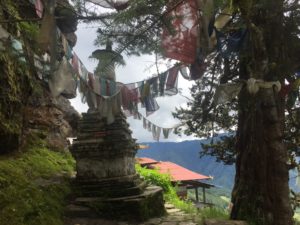
This stupa at the complex was built around Pema Lingpa’s heart stone.
Mythological Origins
Kunzangdrak does not have a mythological foundation story (at least that I am aware of) like other Buddhist sites in Bhutan, but several key figures in Tibetan Buddhist mythology have ties to the monastery.
Characters:
Yeshe Tsogyel is known as the Mother of Tibetan Buddhism and as Female Buddha. She lived from the mid-eighth century to the early ninth century and was a Tibetan princess. Her main desire was to practice the teachings of the Dharma but her father married her off to Trisong Detsen (a Tibetan emperor who helped to spread Buddhism in the Himalayas) to prevent war. After Trisong Detsen invited Padmasambhava to Tibet to ward off evil spirits threatening the construction of Samye (the first Buddhist monastery in Tibet), he gave Yeshe to Padmasambhava as a disciple. Under Padmasambhava’s guidance, Yeshe studied the Dharma and eventually attained Enlightenment at Tiger’s Nest (Taktshang). Legend says that she turned into a flying tigress to escort Padmasambhava down from Taktshang. Though a powerful force, she is said to appear as a normal woman to be more approachable to everyday people. Her connection to Kunzangdrak is that she used one of the caves, now Khandroma Lhakhang, in the area as a meditation cave.
Padmasambhava, also known as Guru Rinpoche, was from India and lived during the eighth and ninth centuries. After Trisong Detsen invited him to calm the evil spirits surrounding the construction site of Samye Monastery, he traveled around the Himalayas converting demons to protectors of Buddhism. During his travels, he founded the Nyingma tradition (the oldest tradition of Himalayan Buddhism) and spread Buddhism in Bhutan (though he did not introduce Buddhism to Bhutan). He also worked with translators and his disciples to translate the Dharma into Tibetan. He is said to have visited the site where Kunzangdrak now stands on his flying tigress (formerly known as Yeshe Tsogyel). Supposedly, he hid sacred treasure at the site and delivered a prophecy from the cliff where Kunzangdrak now stands.
Pema Lingpa is a Bhutanese saint in the Nyingma tradition who lived from 1450-1521. Born in Bumthang, he was the incarnation of Princess Pemasel, daughter of Trisong Detsen and carrier of the Seminal Heart of the Dakinis, a Treasure teaching given to her by Padmasambhava before she died. He was also the incarnation of Longchenpa (who was an incarnation of Pemasel), a Treasure revealer who came to Bhutan in 1350. According to a prophecy, Pema Lingpa was supposed to reveal 108 of Padmasambhava’s Treasure teachings. However, he only revealed 30-40 during his lifetime, with the idea that his incarnations would reveal the rest. During his travels in Bhutan, he met some opposition at what is now called Burning Lake in the Choekhor Valley of Bumthang. The crowd believed he was a false prophet who revealed inauthentic Treasures. According to legend, he lit a butter lamp and claimed that if he jumped into Burning Lake with the lamp, he would return with a Treasure and the lamp still lit. Because of his success in bringing up a small box and sculpture, along with the lit lamp, the onlookers had faith in his teachings and became his patrons. In addition to Kunzangdrak, Pema Lingpa also built many other temples, including Tamshing (Choekhor Valley, Bumthang) and Peling Lhakhang (Taktse, Trongsa).
Pema Lingpa died in 1521 in Tamshing Monastery while with his son, Dawa Gyeltsen. The location of his remains is disputed, with some saying they are located in a stupa in Yungdrung Choling Monastery in Trongsa, and others saying they are located in a stupa at Punakha Dzong. According to the Lama of Yungdrung Choling Monastery, while Pema Lingpa’s remains were in their original location in Tamshing Monastery, monks switched Pema’s remains with his son’s, so any potential stupa robbers would not take Pema’s remains. At one point, Bhutanese officials came to take Pema Lingpa’s remains to Punakha. They asked a monk to swear that the remains in the stupa they were about to take the remains from were truly Pema Lingpa’s. The monk, not wanting the officials to remove Pema’s remains from his monastery, put a small statue of Pema in the cuff of his goh, pointed to his sleeve while appearing to point to the stupa, and swore that it was Pema Lingpa. The officials took the remains of his son instead. The House of Wangchuk (Bhutan’s royal family) and the 6th Dalai Lama are descendants of Pema Lingpa.
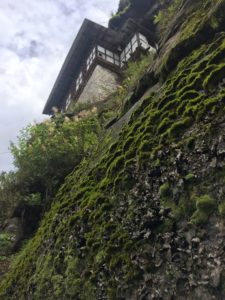
Holy water drips from these rocks
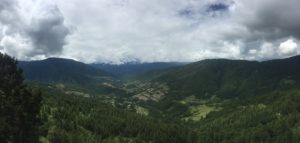
View of the Tang Valley from Kunzangdrak
Modern Visitors
Kunzangdrak does not get many visitors (maybe one to two per day) due to its location off the beaten path and the lengthy hike to the monastery. However, it may see around 100 people on Buddhist holidays or festivals. One may even catch ritual dances at Kunzangdrak on a festival day. Unlike Chimi Lhakhang, visitors do not visit for a specific purpose, instead just coming to visit the temple, perhaps make an offering, and receive a blessing. In one case, a family brought their mute child to Kunzangdrak for a blessing and the child began speaking soon after. Blessings can come directly from a monk, or visitors can tap their head against one of Pema Lingpa’s printing blocks to receive a blessing. In addition to receiving a blessing, visitors can cleanse their sins by circumambulating around the temple on the kora path or around a butter lamp while holding a large stone bearing Pema Lingpa’s footprint on their head.
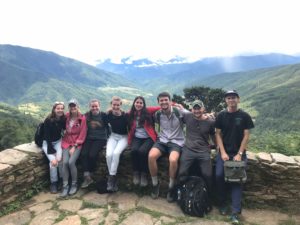
Some modern visitors!
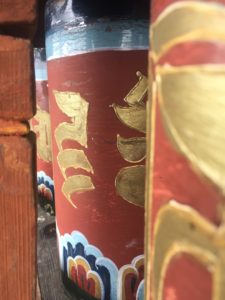
Prayer wheels along the kora path
Fun Facts
- In accordance with traditional Bhutanese architecture, builders used no nails in the construction of Kunzangdrak.
- Kunzangdrak houses many sacred relics belonging to Pema Lingpa, including a stone with his footprint impressed in it, his blacksmithing anvil, his autobiography, and the textbook that he wrote.
- Pema Lingpa made the statue of Guru Rinpoche in one of the temples.
- The monastery features the home of Pema Lingpa. His meditation cave is located in an area that currently serves as an outdoor kitchen for the monastery. Supposedly, the door to his bedroom is exactly his height, which was under 5 feet tall. His bedroom also features a copper statue that he made of himself. According to legend, the statue can grant long-term wishes to those who ask. However, visitors are only allowed to peek into his room, deterring any wish-seekers.
- The main temple, Wangkhang, displays Pema Lingpa’s printing blocks.
- There is a lake near the monastery’s campus. However, visitors are not allowed to visit for fear of disrupting the local deities.


Photo courtesy of Finley Stewart

Pema Lingpa’s meditation cave. There are many caves surrounding the monastery.
References
Dalton, Jacob. “Padmasambhava.” The Treasury of Lives, June 2015, treasuryoflives.org/biographies/view/Padmasambhava/TBRC_P4956.
Gardner, Alexander. “Yeshe Tsogyel.” The Treasury of Lives, Khyentse Foundation, Jan. 2018, treasuryoflives.org/biographies/view/Yeshe-Tsogyel/10373.
Lonely Planet. “Kunzangdrak Goemba in Tang Valley.” Lonely Planet, Lonely Planet, 2017, www.lonelyplanet.com/bhutan/tang-valley/in-location/sights/7fb668ff-7878-4cd9-8500-9231da128d10/a/nar/7fb668ff-7878-4cd9-8500-9231da128d10/1335543.
Maki, Ariana. “Pema Lingpa.” The Treasury of Lives, Apr. 2011, treasuryoflives.org/biographies/view/Pema-Lingpa/3000.
Pommaret, Francoise. “The Tang Valley: Kunzangdra Monastery.” Bhutan: Himalayan Mountain Kingdom, translated by Elisabeth B Booz and Howard Solverson, Odyssey Books & Guides, 2009, pp. 249–250.
Special thanks to Kevin Vose, Norzang Chhoeda, and the monk at Kunzangdrak for providing much of this information!
Lauren Croissant